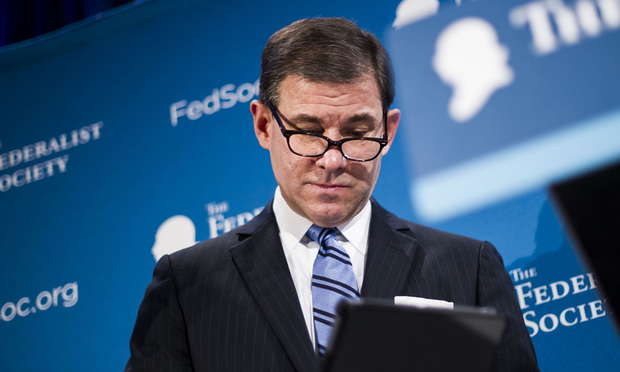 Judge William Pryor Jr. of the U.S. Court of Appeals for the Eleventh Circuit. Credit: Diego M. Radzinschi / ALM
Judge William Pryor Jr. of the U.S. Court of Appeals for the Eleventh Circuit. Credit: Diego M. Radzinschi / ALM
Federal appellate Judge William Pryor Jr., a favorite among conservatives for a seat on the U.S. Supreme Court, took to The New York Times op-ed pages to denounce a conservative law professor’s controversial proposal urging Congress to quickly and greatly expand the federal courts.
Pryor, who sits on the U.S. Court of Appeals for the Eleventh Circuit, said in the opinion piece “there is nothing conservative—or otherwise meritorious—about this proposal,” authored by Steven Calabresi of Northwestern University Pritzker School of Law and one of his former students, Shams Hirji.
Calabresi’s article, published this month under the headline “Proposed Judgeship Bill,” argued that the federal courts are “woefully understaffed” and that the courts are buckling from crushing caseloads. The proposal, styled in the form of a memorandum to Congress, also claimed the courts hear too few arguments and issue too many unpublished rulings.
“None of this is true,” Pryor declared in his op-ed. He continued: “Professor Calabresi writes as if the judiciary should perform its work as it did when he served as a law clerk in the 1980s for two appellate judges and for Justice Antonin Scalia. But the federal docket and court processes have changed a lot since then—often because of changes championed by conservatives.”
Calabresi’s proposal claimed that the caseloads of federal district and circuit courts have increased to such high levels over the past 25 years that those courts now have a “crisis in volume.” The article urged Congress to add 61 new appellate judges and 200 new district court judges—about 33 percent more than currently serve.
 Steven Calabresi.
Steven Calabresi.
“With Republican control over the federal government now, the 115th Congress has a rare opportunity to remedy this grave problem by passing a judgeship bill that would greatly expand the size of the circuit and district courts,” Calabresi and Hirji wrote. “Furthermore, it could accomplish this in a cost-effective manner by abolishing 158 of the most powerful administrative law judges and replacing them with Article III administrative law judges; this would also help restore the separation of powers and rule of law to agency adjudications. In doing so, Congress could achieve another important reform: undoing the judicial legacy of President Barack Obama.”
The authors suggested using the “reconciliation process,” which would block a potential filibuster by Senate Democrats as the vehicle for adopting their proposal, and to move quickly before the 2018 elections.
Not surprisingly, the proposal triggered negative feedback almost immediately from the liberal end of the spectrum, including from University of Michigan Law School’s Richard Primus and University of Chicago Law School’s Geoffrey Stone, who tweeted:
This is truly disgusting. Steven Calabresi should be ashamed of himself for stooping so low. https://t.co/R3LrtXSDE9
— Geoffrey Stone (@stone_geoffrey) November 18, 2017
Criticism also came from libertarian Ilya Somin of George Mason University Antonin Scalia Law School.
Somin blogged that court-packing plans from either the left or the right, if approved, would be a “very dangerous development.” Court-packing, he wrote, is a “menace to the role of judicial review as a check on the power of political majorities.”
Pryor used his own court as an example to test Calabresi’s proposal. Under Calabresi’s proposal, the Eleventh Circuit optimally should have 56 judges, even though it “expeditiously” handles its current caseload with 12 judges. The Fourth Circuit would have 57 judges; the Fifth Circuit, 53 and the Ninth Circuit, 79.
“No appellate court could operate on that scale; judges who must decide appeals collegially would barely know one another. Jumbo appellate courts would be unmanageable,” Pryor wrote.
Calabresi and Hirji have responded to some of their critics. Writing in National Review on Nov. 24, they said their proposal was a “court-unpacking” plan. “ Our proposal simply would restore the judiciary to what would have been the status quo but for Democratic court-packing,” they wrote.
They said their proposal “also addresses the fact that 90 percent of appeals in most circuit courts are now disposed of in memorandum opinions, written by law clerks, and with no allowance for a hearing,” and by law clerks with essentially no judicial supervision.
“This is a national scandal of epic proportions,” they argued, which Congress should address “by counteracting Democratic court-packing by President [Jimmy] Carter and the Democratic Congress in 1978.”
An unconvinced Pryor concluded his op-ed with this line: “I have long admired Professor Calabresi. But his proposal to create hundreds of new federal judgeships should be opposed.”
Read more:
D.C. Circuit’s Harry Edwards Finds Collegiality Trumps ‘Irascible Personalities’
Trump’s Supreme Court Wish List Grows By Five Judges
‘You’re a Bunch of Radicals,’ Gorsuch Jokes at Federalist Society Dinner
Clarence Thomas Is Heralded as ‘Most Original Thinker’ at Supreme Court


